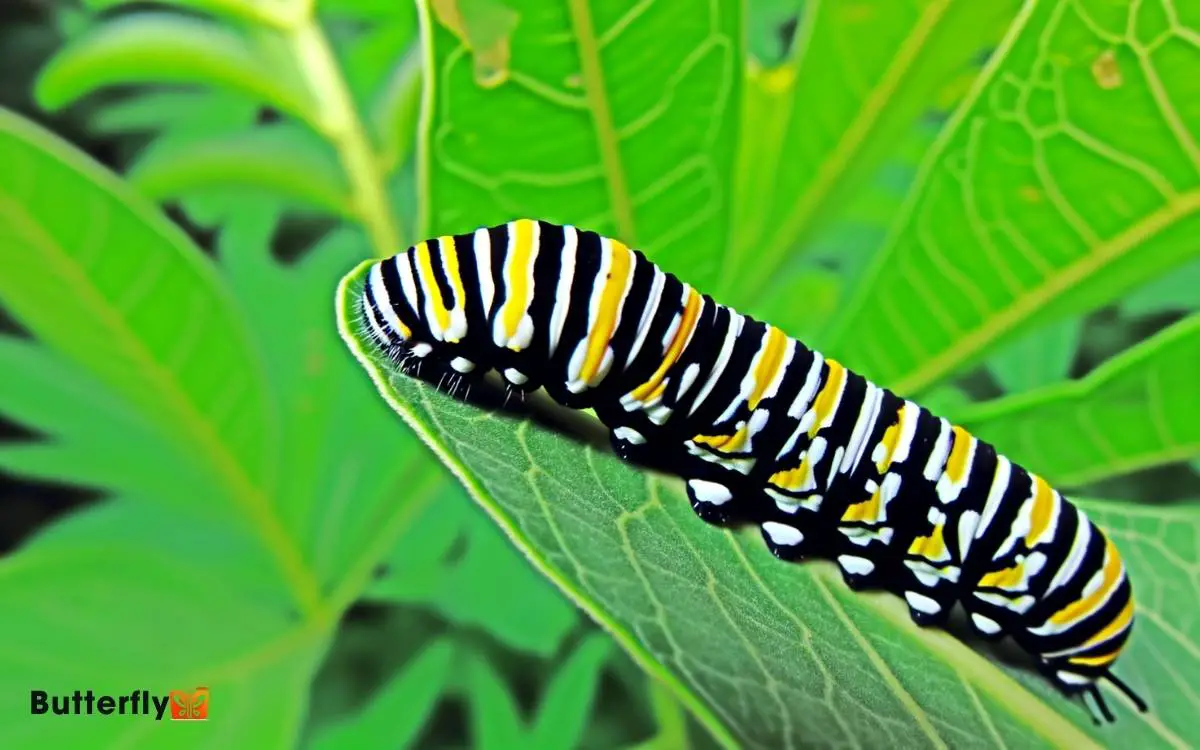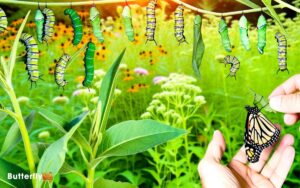Monarch Butterfly Caterpillar Look Alike: Discover Species!
When identifying the Monarch butterfly caterpillar, you’ll notice it has black, white, and yellow striping, along with two pairs of black filaments.
- However, the Viceroy caterpillar mimics Monarchs with brown and white bands and spiny projections.
- Queen caterpillars share the same colors but thrive in warmer climates.
- The Black Swallowtail has green bodies with black bands and yellow spots.
- The Eastern Tiger and Spicebush Swallowtails exhibit Batesian mimicry, with false eyespots and green coloration, respectively.
Each species has unique traits, from habitat preferences to defensive mechanisms. Discovering these distinctions can greatly aid in your understanding of caterpillar diversity.

Key Takeaways
Viceroy Caterpillar
In your search for Monarch butterfly caterpillar look-alikes, you’ll find that the Viceroy caterpillar presents a fascinating case of mimicry and adaptation.
Classified as Limenitis archippus, the Viceroy’s larva exhibits remarkable resemblance to the Monarch’s.
You’ll observe that both caterpillars display similar coloration and patterns, with the Viceroy featuring a brown and white banded body, often adorned with spiny projections. This mimicry deters predators, leveraging the Monarch’s known toxicity.
Unlike the Monarch, the Viceroy caterpillar’s primary host plants are willows and poplars, rather than milkweed. By adopting these visual cues and habitat preferences, the Viceroy enhances its survival chances.
Your observations will underscore the intricate evolutionary strategies employed by these species to thrive in their ecosystems.
Queen Butterfly Caterpillar
You’ll notice that the Queen butterfly caterpillar (Danaus gilippus) shares similar color patterns with the Monarch, characterized by its black, white, and yellow striping. This species prefers habitats with milkweed plants, just like the Monarch.
Their life cycle stages, including egg, larva, pupa, and adult, closely mirror those of the Monarch, making them another intriguing look-alike.
Similar Color Patterns
Queen butterfly caterpillars exhibit strikingly similar color patterns to monarch butterfly caterpillars, characterized by their black, white, and yellow stripes.
You’ll notice that both species display longitudinal stripes along their bodies, which serve as aposematic coloration to deter predators.
The Queen caterpillar, Danaus gilippus, shares this warning coloration with Monarch caterpillars, Danaus plexippus, making them difficult to distinguish at a glance.
Upon closer examination, Queen caterpillars have three pairs of black filaments two anterior and one posterior whereas Monarchs possess two pairs. Additionally, Queens have more pronounced bands of white interspersed with the yellow and black.
This mimicry benefits both species by enhancing their survival through a shared predator avoidance strategy known as Mülle rian mimicry.
Habitat Preferences
When examining the habitat preferences of Queen butterfly caterpillars, you’ll find they mainly thrive in areas abundant with milkweed plants. These caterpillars exhibit a strong preference for Asclepias species, where they can feed and grow.
You’ll often observe them in open fields, roadsides, and disturbed areas where milkweed is prevalent. They favor warm climates, typically found in regions extending from the southern United States to Central and South America.
Queen caterpillars require milkweed not only for nourishment but also as a chemical defense mechanism. By ingesting the plant’s toxic compounds, they deter predators.
Understanding their habitat preferences helps in discerning their ecological niche and aids in conservation efforts. This specificity highlights the importance of preserving milkweed-rich environments.
Life Cycle Stages
Starting as a tiny egg laid on the underside of a milkweed leaf, the Queen butterfly caterpillar undergoes a fascinating metamorphosis through distinct life cycle stages.
First, the egg hatches into a larva, or caterpillar, displaying vibrant black, white, and yellow stripes. As the larva feeds voraciously on milkweed, it undergoes a series of molts called instars. Each instar reveals a larger, more developed caterpillar.
After the final molt, the larva progresses into the pupal stage, forming a chrysalis. Within this protective casing, the transformation into an adult butterfly occurs.
The final stage is eclosion, where the adult Queen butterfly emerges, ready to begin the cycle anew. Understanding these stages helps appreciate the complexity of Lepidopteran development.
Black Swallowtail Caterpillar
You’ll notice the Black Swallowtail caterpillar, Papilio polyxenes, exhibits distinctive color patterns with its striking green body adorned with black bands and yellow spots.
This species thrives in diverse habitats, including gardens and meadows, across North America. Its diet primarily consists of plants in the Apiaceae family, such as dill and parsley, which supports its rapid growth and development.
Distinctive Color Patterns
Amidst the diverse Lepidoptera, the Black Swallowtail caterpillar, Papilio polyxenes, exhibits distinctive color patterns characterized by alternating bands of black and yellow-green, punctuated by rows of small, white dots.
You’ll notice these striking bands create a vivid contrast, making this caterpillar easily recognizable.
| Color | Pattern |
|---|---|
| Black | Alternating bands |
| Yellow-Green | Alternating bands |
| White | Small, punctuating dots in rows |
The black bands feature circular yellow spots, while the yellow-green bands are more uniform in color. These patterns serve as a form of aposematism, warning potential predators of the caterpillar’s unpalatability.
The precise arrangement and vivid hues play a significant role in its survival, enhancing its ability to deter threats effectively.
Habitat and Distribution
The Black Swallowtail caterpillar thrives in diverse habitats, ranging from gardens and meadows to roadsides and agricultural fields across North America.
You’ll find these caterpillars primarily in regions where their host plants, such as members of the Apiaceae family, flourish. Their adaptability allows them to colonize both rural and urban environments.
Observers often note their preference for sunny, open areas, though they can also persist in partially shaded locales. Geographically, their distribution spans from southern Canada to northern Mexico.
By employing a strategy of wide habitat tolerance, the Black Swallowtail ensures its survival across various climatic conditions.
This broad distribution highlights the species’ ecological versatility and resilience. Understanding their habitat is vital for conservation efforts and ecological studies.
Diet and Growth
Starting as voracious feeders, Black Swallowtail caterpillars primarily consume plants from the Apiaceae family, such as parsley, dill, and fennel.
You’ll notice their distinctive, green bodies marked with black bands and yellow spots as they voraciously munch on foliage.
These larvae exhibit rapid growth, undergoing several molts, or instars, as they progress toward pupation. Each instar sees the caterpillar shedding its exoskeleton, allowing for substantial size increases and morphological changes.
You’ll find that their dietary preferences play an essential role in their development and survival. The plants they consume not only provide essential nutrients but also incorporate toxins that deter predators.
Observing these caterpillars, you’ll appreciate the intricate balance of diet and growth in their life cycle.
Eastern Tiger Swallowtail
Eastern Tiger Swallowtail caterpillars (Papilio glaucus) closely mimic the appearance of the Monarch butterfly caterpillar, with their striking yellow and black coloration serving as a form of Batesian mimicry.
This mimicry confers a survival advantage by deceiving predators into thinking they are as toxic as Monarchs.
Here’s a comparison to help you understand the differences:
| Feature | Eastern Tiger Swallowtail | Monarch Butterfly |
|---|---|---|
| Primary Coloration | Yellow with black bands | Yellow with black and white bands |
| Eye Spots | Prominent false eyespots | Absent |
| Size at Maturity | Up to 6 cm | Up to 5 cm |
| Preferred Host Plants | Willow, Cherry, Birch | Milkweed |
Despite similarities, these caterpillars prefer different host plants and exhibit unique behaviors.
Spicebush Swallowtail
Unlike the Eastern Tiger Swallowtail, the Spicebush Swallowtail (Papilio troilus) caterpillar employs a different mimicry strategy, resembling a small green snake with its green body and prominent eyespots to deter predators.
You’ll observe that the first three larval instars are brown and resemble bird droppings, providing camouflage. By the fourth instar, it turns bright green with large, false eyespots that imitate a snake’s head, effectively warding off potential threats.
The caterpillar’s unique mimicry extends to its behavior, as it often remains motionless when disturbed, enhancing the snake illusion.
Spicebush Swallowtails primarily feed on spicebush (Lindera benzoin) and sassafras (Sassafras albidum), making them specialists in their ecological niche.
Their transformation into striking black and blue butterflies is equally fascinating.
Red Admiral Caterpillar
The Red Admiral (Vanessa atalanta) caterpillar features a spiny, black body adorned with pale yellow speckles, providing it with a unique appearance among nymphalid larvae.
You’ll notice that its body is covered in numerous branched spines, offering effective protection against predators.
Unlike the smooth-bodied Monarch caterpillar, the Red Admiral’s spiny texture is a distinguishing feature.
The caterpillar often resides on nettles (Urtica spp.), constructing shelters by folding leaves together with silk. Its diet primarily consists of nettle leaves, a preference that’s essential for its development.
As you observe, the caterpillar’s coloration and behavior serve as effective camouflage, reducing predation risk. This species undergoes several instars before pupating, eventually emerging as a strikingly beautiful butterfly.
Soldier Butterfly Caterpillar
You’ll observe that the Soldier Butterfly caterpillar (Danaus eresimus) exhibits distinctive color patterns with its black, yellow, and white bands. It primarily feeds on milkweed species, similar to the Monarch caterpillar.
This mimicry not only aids in its defense mechanisms but also highlights its evolutionary adaptation to its environment.
Distinctive Color Patterns
One can easily identify the Soldier Butterfly caterpillar by its striking black and yellow stripes, which mimic the Monarch caterpillar’s but exhibit more defined and narrower banding.
You’ll notice that the Soldier Butterfly caterpillar, scientifically classified as *Danaus eresimus*, possesses a more pronounced segmentation in its color pattern.
Unlike the Monarch, the Soldier’s stripes are more consistent in width and spacing, providing a more regimented appearance.
Additionally, the white dots interspersed along the black bands are more prominent, adding to the distinct visual signature. This precise coloration serves as a defensive mechanism, deterring predators by signaling potential toxicity.
Host Plant Preferences
When observing the host plant preferences of the Soldier Butterfly caterpillar, you’ll find it mainly feeds on various species of milkweed, including Asclepias curassavica and Asclepias incarnata.
These plants belong to the Apocynaceae family and are vital for the caterpillar’s development. Milkweed provides essential nutrients and secondary metabolites like cardenolides, which the caterpillars sequester for protection.
You’ll notice that the caterpillars exhibit a preference for younger, tender leaves, as these contain higher concentrations of these beneficial compounds. The caterpillars’ feeding habits have a significant impact on the plants, often leading to defoliation.
Mimicry and Defense Mechanisms
The Soldier Butterfly caterpillar employs both mimicry and chemical defenses to deter predators and increase its chances of survival.
You’ll notice that it mimics the Monarch caterpillar, sharing similar coloration with black, white, and yellow stripes. This mimicry confuses predators who associate the coloring with the toxic Monarch.
Additionally, the Soldier Butterfly caterpillar produces toxic chemicals called cardenolides, which make it unpalatable to predators. This dual strategy of visual mimicry and chemical defense enhances its survival.
| Characteristic | Monarch Caterpillar | Soldier Caterpillar |
|---|---|---|
| Coloration | Black, white, yellow | Black, white, yellow |
| Toxicity | High | High |
| Defense Mechanism | Cardenolides | Cardenolides |
| Primary Predator | Birds | Birds |
Understanding these mechanisms reveals the sophisticated strategies caterpillars use to thrive.
Painted Lady Caterpillar
A close examination reveals that the Painted Lady caterpillar, Vanessa cardui, exhibits distinctive spiny bristles and a varied color pattern, which can sometimes be mistaken for the Monarch butterfly caterpillar.
You’ll observe that the Painted Lady caterpillar has a black or dark brown body adorned with yellow stripes and numerous spines.
These spines serve as a defense mechanism against predators. Unlike the Monarch caterpillar’s smooth body, the Painted Lady’s bristles give it a more rugged appearance.
Their habitat includes a wide range of host plants such as thistles, mallows, and hollyhocks. Understanding these subtle differences helps you accurately identify and classify these caterpillars, enhancing your knowledge of Lepidoptera and their fascinating mimicry strategies.
Pipevine Swallowtail
Pipevine Swallowtail caterpillars, Battus philenor, display a striking dark coloration with vivid red-orange tubercles, making them another potential look-alike to the Monarch butterfly caterpillar.
You’ll notice their jet-black body, which possesses a velvety texture, adorned with prominent red to orange tubercles along the dorsal surface. These tubercles serve as a warning coloration, signaling toxicity to potential predators.
Unlike Monarch caterpillars, Pipevine Swallowtails have a more cylindrical shape and lack the distinctive white, yellow, and black banding. Their exclusive diet consists of Aristolochia species, commonly known as pipevines, which imbue them with toxic compounds.
This diet-induced toxicity is an important defensive mechanism. Understanding these characteristics will help you differentiate between these fascinating caterpillars in their natural habitats.
Fritillary Caterpillars
When examining fritillary caterpillars, you’ll notice their spiny bodies adorned with striking orange and black coloration, distinguishing them from Monarch caterpillars.
These caterpillars belong to the genus Speyeria, frequently spotted on violet (Viola spp.) leaves, their primary host plants.
Their spines, unlike Monarch’s smooth bodies, provide a formidable defense against predators. You’ll also observe that fritillary caterpillars exhibit a more uniform color pattern, with orange bands segmented by black spines.
This coloration serves as a warning signal, leveraging aposematism to deter predation.
Swamp Milkweed Leaf Beetle
While fritillary caterpillars showcase their vivid spines, the Swamp Milkweed Leaf Beetle (Labidomera clivicollis) displays its own distinctive traits, characterized by an oval-shaped body with bright orange and black markings.
You’ll notice that their elytra (wing covers) are adorned with a striking pattern, making them easily identifiable.
These beetles thrive on Asclepias incarnata, commonly known as swamp milkweed, and play a role in the ecosystem by consuming its leaves.
Their larvae, often mistaken for caterpillars, exhibit similar coloration, helping them blend into their habitat. Unlike caterpillars, the beetle larvae have a more segmented, less cylindrical body.
Observing both adults and larvae will give you insights into their life cycle and ecological importance.
Identifying Caterpillar Differences
To distinguish between caterpillars, focus on key features such as body shape, coloration, and specific markings. Monarch caterpillars exhibit distinct black, white, and yellow striping, with two pairs of black filaments one pair on each end.
In contrast, the viceroy caterpillar mimics the appearance of bird droppings, displaying a mottled brown and white pattern. Additionally, the queen butterfly caterpillar shares similar striping to the monarch but includes additional red spots.
Pay attention to the number of prolegs; monarchs typically have five pairs. Examining the host plant can also help; monarchs prefer milkweed.
Conclusion
In distinguishing monarch butterfly caterpillars from their look-alikes, you’ll need keen observation and precise classification. Viceroy caterpillars have a different banding pattern; Queen caterpillars exhibit distinct spots.
Black Swallowtail caterpillars display unique yellow dots, while Eastern Tiger Swallowtails have striking stripes. Spicebush Swallowtails feature eye-like spots; Pipevine Swallowtails are darker.
Fritillary caterpillars have spiny textures, and Swamp Milkweed Leaf Beetles present a beetle-like form. Recognizing these differences guarantees accurate identification and enhances understanding of lepidopteran diversity.






